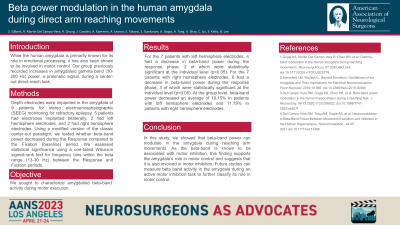Beta power modulation in the human amygdala during direct arm reaching movements
Beta Power Modulation in the Human Amygdala During Direct Arm Reaching Movements
Friday, April 21, 2023


Zachary Gilbert, BS
Medical Student
Keck School of Medicine of USC
ePoster Presenter(s)
Introduction: While the human amygdala is primarily known for its role in emotional processing, it has also been shown to be involved in motor control. Our group previously recorded increases in amygdaloid gamma band (30-200 Hz) power, a prokinetic signal, during a center-out direct-reach task. In the current study, we sought to characterize amygdaloid beta-band activity during motor execution.
Methods: Depth electrodes were implanted in the amygdala of 9 patients for stereo electroencephalographic (SEEG) monitoring for refractory epilepsy. 5 patients had electrodes implanted bilaterally, 2 had left hemisphere electrodes, and 2 had right hemisphere electrodes. Using a modified version of the classic center-out paradigm, we tested whether beta-band power decreased during the Response compared to the Fixation (baseline) period. We assessed statistical significance using a one-tailed Wilcoxon signed-rank test for frequency bins within the beta range (13-30 Hz) between the Response and Fixation periods.
Results: For the 7 patients with left hemisphere electrodes, 4 had a decrease in beta-band power during the response phase, 2 of which were statistically significant at the individual level (p < 0.05). For the 7 patients with right hemisphere electrodes, 6 had a decrease in beta-band power during the response phase, 3 of which were statistically significant at the individual level (p < 0.05). At the group level, beta-band power decreased an average of 10.15% in patients with left hemisphere electrodes and 11.19% in patients with right hemisphere electrodes.
Conclusion : In this study, we showed that beta-band power can modulate in the amygdala during reaching arm movements. As the beta-band is known to be associated with motor inhibition, this finding supports the amygdala’s role in motor control and suggests that it is also involved in motor inhibition. Future studies can measure beta band activity in the amygdala during an active motor inhibition task to further classify its role in motor control.
Methods: Depth electrodes were implanted in the amygdala of 9 patients for stereo electroencephalographic (SEEG) monitoring for refractory epilepsy. 5 patients had electrodes implanted bilaterally, 2 had left hemisphere electrodes, and 2 had right hemisphere electrodes. Using a modified version of the classic center-out paradigm, we tested whether beta-band power decreased during the Response compared to the Fixation (baseline) period. We assessed statistical significance using a one-tailed Wilcoxon signed-rank test for frequency bins within the beta range (13-30 Hz) between the Response and Fixation periods.
Results: For the 7 patients with left hemisphere electrodes, 4 had a decrease in beta-band power during the response phase, 2 of which were statistically significant at the individual level (p < 0.05). For the 7 patients with right hemisphere electrodes, 6 had a decrease in beta-band power during the response phase, 3 of which were statistically significant at the individual level (p < 0.05). At the group level, beta-band power decreased an average of 10.15% in patients with left hemisphere electrodes and 11.19% in patients with right hemisphere electrodes.
Conclusion : In this study, we showed that beta-band power can modulate in the amygdala during reaching arm movements. As the beta-band is known to be associated with motor inhibition, this finding supports the amygdala’s role in motor control and suggests that it is also involved in motor inhibition. Future studies can measure beta band activity in the amygdala during an active motor inhibition task to further classify its role in motor control.
